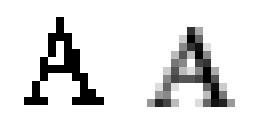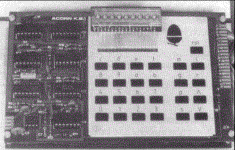 | Acorn History |
|
Hermann Hauser, who had studied physics at Cambridge University, first founded Cambridge Processor Unit to do consultancy work on electronic design. He decided to produce a simple computer kit and a prototype was designed by Roger Wilson (also at Cambridge University) in late 1978. In 1980 a new model of computer, broadly based on the System 1 but incorporating a keyboard, was launched. This was the Acorn Atom and one of the best low-priced computers of the time. In 1981 Acorn were awarded the contract to make a computer to accompany the British Broadcasting Corporation's new television series on microcomputers, "The Computer Program", which was first broadcast on 11th January 1982. To meet the short deadline Acorn adapted a new computer they had been developing, which was to have been called the Proton. Thanks to the endorsement of the BBC, Acorn's machine sold very well, despite its fairly high price of £400, in particular to schools and higher education establishments. It was very profitable for Acorn and a derivative, the BBC Master 128, was on sale until 1993. Around 1983-84 Acorn began considering a replacement for their BBC Micro. It was clear that the 8-bit microprocessors used in most home computers of the time were too limiting (they were slow and could only access 64 kilobytes of memory) and so Acorn were looking for a new microprocessor. They considered Intel's 80286 but decided this was inadequate for the next generation of desktop computer they had in mind, so instead they designed their own processor. The main designers were again Steve Furber and Roger Wilson. Since Acorn had no previous experience of microprocessor design, it had to have a simplified structure and so they chose the RISC (Reduced Instruction Set Computer) style. This turned out to be a bonus as it meant the microprocessor needed relatively few components, resulting in low power consumption, and operated at a high speed (for the mid 1980s). The chip was known as the ARM, standing for Acorn Risc Machine. Meanwhile Acorn was having financial difficulties. They had spent a significant amount of cash gaining regulatory approval with regard to radio interference for the BBC microcomputer in America, but did not sell many machines into this market. Also a cheapened version of the BBC micro, the Electron (note the elementary particle theme) failed to sell as well as expected and Acorn were left with excess stock of it. In 1985 a 49% stake in Acorn was sold for £10.4 million to the Italian typewriter and desktop PC maker Olivetti. Later Olivetti paid a further £4 million to increase their holding to 79.8%. Part of the problem for Acorn was that there was too long a time gap between the 8-bit BBC B and their first 32-bit models, during which Acorn machines were losing ground. In 1987 Acorn produced their first computer using the new ARM processor, the Archimedes. This was an outstanding computer for the time, running several times faster than the current IBM PC compatibles and with high resolution colour graphics and advanced sound facilities. The Archimedes could run most of the vast amount of software which by then existed for the BBC micro via a software emulator, and its many screen modes included those of the BBC. It also introduced anti-aliased text to desktop computers, via font management software written by Sophie Wilson. Anti-aliasing means that the colour of text is gradually shaded into the background colour around the edges, which makes it much more pleasant to read on a relatively low resolution computer monitor. Microsoft introduced anti-aliasing into WindowsTM in 1998.  Magnified views of a capital A, on the left without anti-aliasing, and on the right with anti-aliasing. At normal size you do not see the individual squares making up the anti-aliased form but instead see a neatly formed letter. The Archimedes and its derivatives such as the A4000, A5000 and A3010 sold moderately well, especially to Acorn's traditional market of schools, but not in large numbers to home users, despite having one of the best user interfaces of the early 1990s in RISCOS. The last significant desktop computer produced by Acorn was the RISC PC of 1994. This used an ARM 610 processor clocked at 32 MHz, making it faster than most IBM compatibles, and added full 24-bit colour display modes. It also had a separate daughter board to hold the microprocessor and support chips which made it possible to replace the original processor with one with completely different pin-outs. In collaboration with Digital Equipment Corporation, Acorn produced the StrongArm version of their processor in 1997. This was clocked at 200 MHz and, in tandem with the highly efficient operating system, meant RISC PCs fitted with StrongArm processors were at that time much faster than 'Wintel' alternatives. However the competition was catching up with Acorn. WindowsTM 95 had brought the first decent operating system to IBM PCs, clock speeds of the new Pentium class processors were rising and colour graphics were now a standard feature of PCs rather than an expensive extra. Schools began to replace Acorn kit with 'standard' WindowsTM machines, because it was claimed pupils would be at a disadvantage if they did not have experience of Microsoft programs. (Although in the early 1980s it was similarly argued that schools had to use computers running the 'industry standard' CP/M operating system. Who remembers CP/M now?) Acorn's previous concentration on the education market to the almost total exclusion of others was now seen as a mistake as their sales began to flag. Work began on a greatly improved version of the RISC PC, codenamed Phoebe, but development went slowly and Acorn made the classic error of announcing the Phoebe long before it was ready, causing potential purchasers to hold off buying a RISC-PC and wait for the new model instead. Acorn had spun off their microprocessor design section under the name of ARM Limited (standing for either Acorn or Advanced Risc Machines, no-one seemed sure) and ARM Ltd was actually doing very well. The low power consumption combined with quite high performance of ARM processors made them ideal for battery powered equipment like PDAs and mobile phones, and they were also much cheaper than Intel Pentium class processors. ARM Ltd grew to the point where Acorn's shares in ARM Ltd were worth more than Acorn the computer business. In 1999 Acorn's shareholders broke up the company to release the value of the ARM Ltd shares. Phoebe never appeared and most of the intellectual property rights relating to RISCOS and Acorn's display technology were sold to Pace Micro Technology. Part of Acorn remained under the name Element 14 (the atomic number of silicon) but this was soon bought by the American networking company Broadcom. ARM Ltd does not manufacture the microprocessors it designs but instead licenses production to other companies. This has allowed ARM to become worth over £1 billion without the huge investment of building fabrication plants. ARM-designed microprocessors now outsell Intel designs since they are used in a large proportion of the mobile phones produced each year. In 2005 1.7 billion chips based on ARM designs were made. The rights to the RISC PC were bought by Castle Technology, who continued until late 2008 to sell a desktop machine called the Iyonix which uses an Intel XScale processor derived from the StrongArm. Advantage Six are currently selling a low priced compact computer called the A9, using an ARM9 processor, or alternatively a fully-functional emulator allowing almost all RISCOS software to be run on a WindowsTM or Macintosh PC is available from Virtual Acorn, or ready-installed on a Windows PC from R-Comp. Steve Furber, now at the University of Manchester, is working on fault-tolerant computers which would continue working if some components failed. A large number of simple microprocessors, perhaps based on the Amulet design which is itself derived from Acorn's ARM processors, will be built onto a single silicon chip. This will reduce manufacturing costs and power consumption. The integrated network of processors will model networks of neurons in the brain, which continue to work even when individual neurons die. As a final twist, the Acorn Computers Limited brand name was resurrected in May 2006 by a company based in Nottingham selling UK-assembled notebook computers using Intel/AMD processors and Windows XP. The intention seems to be to trade on the reputation of the previous Acorn for innovation and quality, especially in the education market. However the new Acorn Computers has no connection to the company that brought us the ARM processor and RISC OS. |
 Some design work on the finished version was done by Steve Furber. A company called Acorn was formed to market the kit, which was named the
Some design work on the finished version was done by Steve Furber. A company called Acorn was formed to market the kit, which was named the